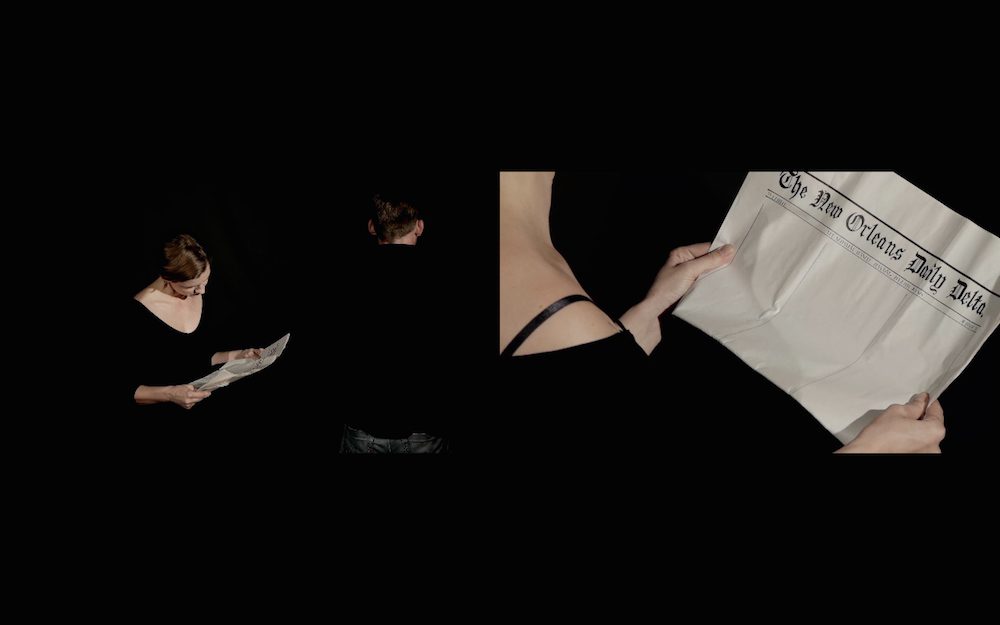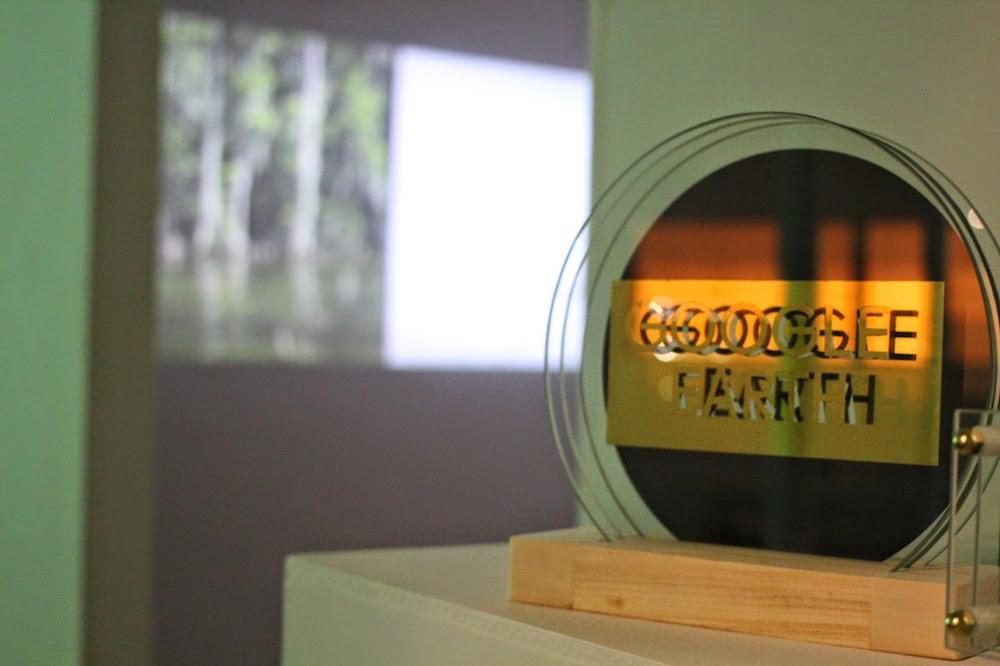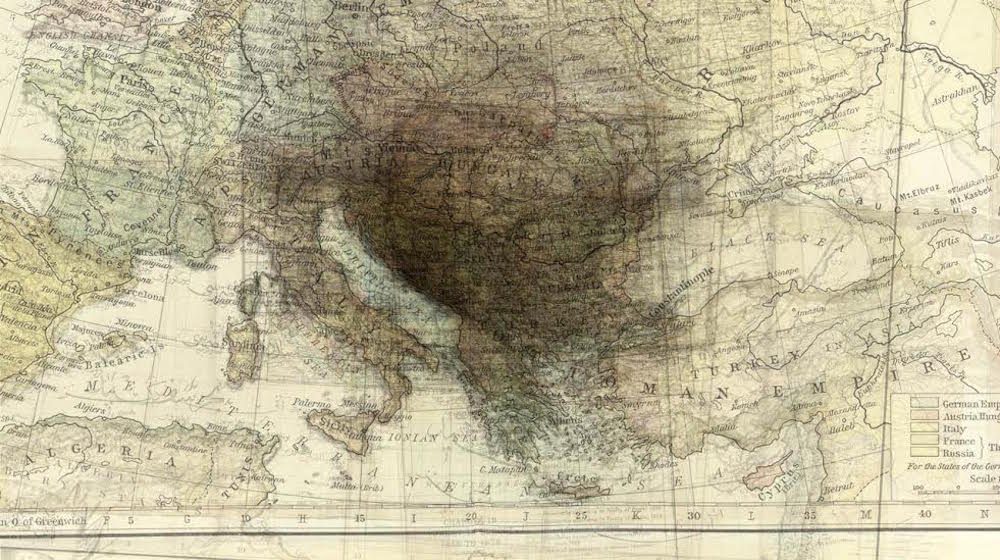Stranger in a Strange Land: "The Horizon Tries" at Good Children Gallery
Charlie Tatum on Lala Raščić's latest show at Good Children Gallery.

VIDEO STILL FROM LALA RAŠČIĆ’S NO COUNTRY OTHER THAN LIBERTY, 2013. COURTESY THE ARTIST.
Beyond the swift and twisting line of the wake, large surfaces of foam pass by, thrown aside to the right and left by the prow of the ship. There are islands, archipelagos, and continents that coalesce, break apart, diminish, dissolve and vanish. In reality, there is not a great difference, geologically speaking, between these continents of foam and the continents of land that we inhabit. Small or large, all phenomena are analogous: our continents will also dissolve and reform elsewhere, like clusters of white bubbles carried along by the wake of the vessel.
Élisée Reclus, A Voyage to New Orleans, translated and edited by John Clark and Camille Martin
“The Horizon Tries”—Lala Raščić’s current show at Good Children Gallery—truly begins in the back of the gallery with a mini archive of texts and materials relating to nineteenth-century geographer and anarchist Élisée Reclus. Reclus fled Louis-Napoleon’s France and traveled to Louisiana in 1853, documenting his journey and his encounters with the rapidly Americanizing city of New Orleans. A Voyage to New Orleans, first published in 1855, begins in typical travelogue fashion with painstaking descriptions of ship parts, foliage, fauna, and the geography of the New World. Very quickly, however, the reader sees that Reclus’s real fascination is with the malleability of a society outside of the constraints of Western European philosophy, ideology, and history. His account focuses on the rocking of the sea, the evanescence of the stars, and the lawlessness of the still young United States of America (Though he was clearly fascinated, Reclus was also highly critical of slavery, gun laws, and the general customs of the country). Ultimately, Reclus’s text is more about movement—of people, of places, of societies—than it is about exploration.
Raščić’s video installation No Country Other Than Liberty rehashes and appropriates Reclus’s text—and its introduction by contemporary translator John Clark—reciting it over a slow pan across the same delta, swamps, and ports that Reclus passed through 150 years ago. Reclus’s descriptions are at once recognizable and foreign, highlighting the timelessness of the delta and the impossibility of predicting its future development. Raščić attempts to illustrate Reclus’s spot-on descriptions of the brown sediment of the Mississippi, the cypress knees and Spanish moss that line the bayous, and the signs of technology and capitalism creeping through the landscape. Still it is impossible for her to recapture the history enacted on this land, and No Country relishes in the inherent disconnect between past and present, words and places.
For Raščić, though, this failure marks a larger inability for man to name, to map, and to confine the natural world. Our attempts to define and to delineate nature—in all its vastness—are necessarily undermined by the limits of language, science, and human thought. This idea reappears with varying results throughout the exhibition, but the strongest works are those that emphasize the acts of translation, such as Raščić’s Geometries of Exploitation series, painted from abstracted screenshots of Google Maps, and her layered glass sculptures in the front room of the gallery. The glass and painted text of these three-dimensional works mimics layers of metadata, exploring the ways in which technology reframes how we make sense of both places and place-names. When the light of the gallery hits the pristine glass with perfectly stenciled letters, it projects overlapping shadowed words and geometric shapes onto the wall—
NATURE CULTURE LANDSCAPE MANSCAPE
GOOGLE EARTH
LANDSCAPE ON THE BRINK OF ABSTRACTION
ZOOM ZOOM ZOOM
—transforming the gallery into a simulacrum of a digital space where words, ideas, and places are constantly sliding into each other.

INSTALLATION VIEW OF LALA RAŠČIĆ'S GEOMETRY OF EXPLOITATION AT GOOD CHILDREN GALLERY, NEW ORLEANS. COURTESY THE ARTIST.
Raščić’s decision to include works by other artists in “The Horizon Tries” is admirable, extending our attention past Southern Louisiana and even the United States. Fokus Grupa’s There Aren’t Words for What We Do or How We Feel So We Have to Make Them Up is shot in national parks in Croatia but constricts our view to indefinable, sun-kissed landscapes filled with rocky cliffs and grazing cattle which could just as easily be located in the rural parts of any country in the Northern Hemisphere. More interesting is Bosnian artist Lana Čmajčanin’s 551.35 – Geometry of Time, which lays map over map documenting the man-made and highly politicized boundaries that have redefined Eastern Europe since Roman times. The layered borders in Čmajčanin’s entrancing video propel us into a black hole, a mass of squiggles drawn by ruler after ruler, far removed from, yet integral to, the lives of the people who have lived and still do live there. For them, these histories cannot be escaped with the eraser and pencil of a cartographer.

VIDEO STILL FROM LANA ČMAJČANIN’S 551.35 – GEOMETRY OF TIME, 2014. COURTESY THE ARTIST.
Though Raščić has framed “The Horizon Tries” around the general idea of man’s exploitation of landscape, the exhibition better highlights a more specific question: what happens when “nature” and all the metadata we’ve attached to it—geography, cartography, imaging, histories—become co-constitutive? What do we do when we can no longer hang on to the idea of a supreme, unadulterated natural world? The physical world around us is inextricable from the knowledge we use to make sense of it and the reach of that knowledge is only increasing. It’s now impossible for many of us to divorce ourselves from the surge of information that we rely on daily, whether driving to a friend’s house, finding the best-rated Vietnamese restaurant nearby, or looking up the contested territory between warring nations. Perhaps the better question is which information and histories we’ll take with us into the future and which we’ll leave behind.
Editor's Note
“The Horizon Tries” on view through March 8 at Good Children Gallery (4037 St. Claude Avenue) in New Orleans.



